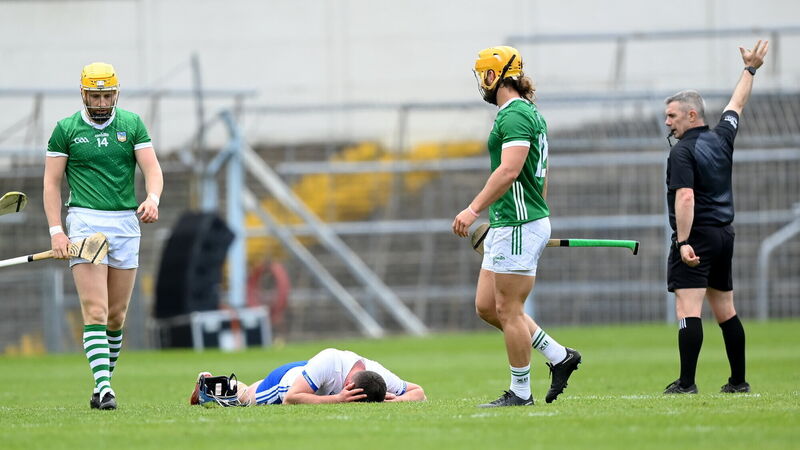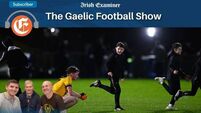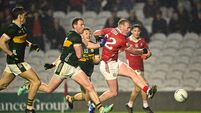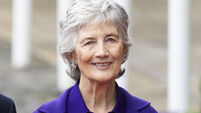Scientific paper recommends heavier punishment for hits to head in hurling

Stephen Bennett of Waterford holds his head following a challenge from Seamus Flanagan of Limerick, left, during the Munster GAA Hurling Senior Championship Round 1 match between Waterford and Limerick at FBD Semple Stadium in Thurles, Tipperary. Photo by Stephen McCarthy/Sportsfile
A 2023 study into concussion in elite hurling has recommended the GAA take more stringent action against “blind side” hits to the head.
The paper, which was published in the “Irish Journal of Medical Science”, proposed heavier sanctions for the dangerous fouls. It also found impacts to the lateral (side) of the head were 2.7 times more likely to result in visible signs of concussion than those to the anteroposterior areas (front and back).
Analysing 82 inter-county hurling games across 2018 and ‘19, 183 potential concussion events (PCEs) were identified by author Mario Rotundo of Ulster University. Shoulder-to-head impacts produced “visible signs of concussion” in 14 of 37 such cases (37.8%), head-to-head impacts in eight of 23 cases (34.8%) and three of 35 hurley to head cases (8.6%).
In Thurles last Sunday, two hurley strikes to the head, one by Barry Nash and the other by Stephen Bennett, were deemed yellow cards, while referee Liam Gordon adjudged Seamus Flanagan’s late shoulder to Bennett’s head in the first half did not warrant a free or a card, believing it to be accidental in real time.
That challenge occurred just two minutes after Nash had made contact with Bennett’s head. As a result of Gordon addressing the incident at the time, the Central Competitions Control Committee were not in a position to propose a retrospective suspension for Flanagan.
Rotundo’s study concludes “players appear to be at a higher risk of SRC (sport-related concussions) later in the match or when receiving the sliotar.” It adds: “Strikes to the lateral aspect of the head and those involving the shoulder appear to produce severe events. These findings provide initial guidance for the development of targeted player protection strategies.”
One of them is to hand down heavy sanctions for the blind blows, when the receiving player has a poor view of the imminent challenge or is not able to anticipate it. “The league (GAA) might consider implementing more severe penalties, especially for "blind-side" hits to the lateral aspect of the head, to encourage players to be more deliberate with their tackles.”
Players, coaches and referees all have a part to play, the study advises. “Players should be taught from an early age that hits to the head, especially from the side on an unsuspecting opponent, can cause severe brain injury.
“Referees might approach high-risk situations with a heightened awareness and have a lower threshold for issuing fouls and cards if necessary. In training, coaches should emphasise ‘heads up’ play and situational awareness, especially when receiving a pass in the centre of the pitch or when carrying the sliotar into the face of the goal.
“The aptly-named “heads up” style of play has been a fixture in ice hockey coaching for many years, which fortunately provides an existing framework that could likely be adapted to hurling.”
The research revealed shoulder-to-head impacts were 6.5 times more likely to result in a severe PCE than a hurley-to-head contact. “For the purposes of player protection, it is helpful to know that shoulders tend to produce severe PCEs. This raises an important question: are shoulder-to-head impacts more dangerous due to the region of the head that they tend to affect?”
Four years ago, the GAA referees development committee instructed match officials that all deliberate head-high fouls were red card offences. “Absolutely zero (tolerance),” said then committee chairman Willie Barrett. “Anything above the shoulders in relation to striking to the head, from the neck up, we’ve instructed our referees clearly, both in hurling and football, to issue a red card for a challenge that’s a deliberate challenge to the head.” Inter-county hurling referees will meet as per schedule next week where the topic is expected to be discussed.











